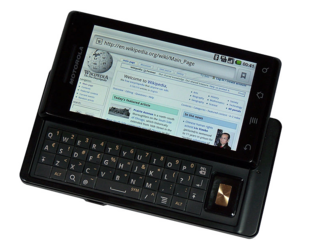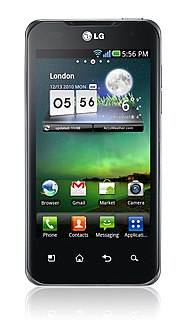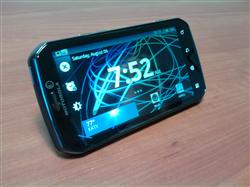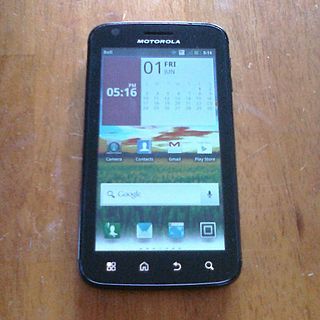The Motorola A760 is a Linux-based camera equipped mobile telephone developed at Motorola's laboratory in China and released in the Chinese market on February 16, 2003. The particular Linux distribution used was MontaVista Linux. It is the first phone to use Linux.

The Motorola Razr was a series of mobile phones by Motorola, part of the 4LTR line. The V3 was the first phone released in the series and was introduced in July 2004 and released in the market in the third quarter of 2004. The V3 model was followed soon thereafter by the much improved V3i with a collaboration with Apple Inc. for iTunes to be built-in.
Motorola Mobility LLC is an American consumer electronics and telecommunications company owned by technology firm Lenovo Group Limited.
The company primarily manufactures smartphones and other mobile devices running the Android operating system developed by Google.
Motoblur was an Android UI replacement and push-based service focused on social networking, developed by Motorola. It aimed at functional similarity to Palm's Synergy, including such features as Remote Wipe. Motoblur included a variety of widgets which combined various social networking portals such as Facebook, MySpace, and Twitter as well as other services all in one place. It also combined multiple email accounts and contact communication sources into singular notification views, being the first handset software to do so. Feeds and data were regularly pushed to these widgets. Motoblur in its final inception was on these devices: Electrify/Photon 4G, Atrix 4G, Atrix HD, CLIQ/DEXT, Backflip, Devour, Flipout, Charm, Spice, Droid Pro, Filpside, DEFY, DEFY+, Bravo, Droid X, Droid 3, Droid 2, Droid Bionic, and Droid RAZR. The version found on the Droid X, Droid Pro, Droid 2, Droid Bionic, Droid 3, Electrify/Photon 4G, and DEFY was intended to be less intrusive than previous versions.

The Motorola Droid is an Internet and multimedia-enabled smartphone designed by Motorola, which runs Google's Android operating system. The Droid had been publicized under the codenames Sholes and Tao and the model number A855. In Latin America and Europe, the model number is A853 (Milestone), and in Mexico, the model number is A854 (Motoroi). Due to the ambiguity with newer phones with similar names, it is also commonly known as the DROID 1, and unofficially nicknamed "OG Droid". The brand name Droid is a trademark of Lucasfilm licensed to Verizon Wireless.
PenTile matrix is a family of patented subpixel matrix schemes used in electronic device displays. PenTile is a trademark of Samsung. PenTile matrices are used in AMOLED displays.
A Nirvana Phone concept refers to a smartphone that can be docked with external displays and keyboards to create an alternative desktop or laptop computer system. This is not any particular brand of phone or software, rather it defines a new category of mobile device with a capability beyond a conventional smartphone computer.
The NirvanaPhone provides the processor, storage media, display adapter, communication channels, and operating system. The docking station provides power, and connectivity. To be useful the NirvanaPhone differs from a simple smartphone by having significant processing power, video output at high resolution, plus keyboard and mouse input. A smartphone is generally accepted as a device that has both mobile phone capability as well as an operating system that can run applications such as email, web browser, media player and personal organizers. The NirvanaPhone adds external monitor capability which could be a computer monitor, an HDTV, or a video projector. The dock could be a cradle, cable or a wireless connection. This allows the NirvanaPhone to run applications that can utilize a full-sized display for better readability or collaboration. Or in combination with a keyboard and mouse, perhaps using Bluetooth, the NirvanaPhone could act as a thin client connected to a virtual desktop for business use.

The Motorola Droid 2 is the fifth phone in Verizon's Droid line. In the U.S., it is available exclusively on Verizon Wireless, and was released August 12, 2010. It runs the Android operating system by Google, and can run Flash Player 10.1. It comes with 8 GB of internal memory and is shipped with an additional 8 GB SDHC card, upgradable to 32 GB. It has a 3.7 in display and a 5-megapixel camera. Unlike the Droid X, the Motorola Droid 2 features a redesigned slide-out QWERTY keyboard, but still features the Swype keyboard found on the Droid X. A limited edition version featuring the Star Wars droid character R2-D2 with exclusive apps and content was announced by Verizon for September 30, 2010, to commemorate the thirtieth anniversary for The Empire Strikes Back.

The Motorola Droid Bionic is an Android-based, 4G LTE-capable smartphone designed by Motorola. It was originally scheduled for release in Q2 2011 but was delayed, eventually being released on 8 September 2011.

The LG Optimus 2X is a smartphone designed and manufactured by LG Electronics. The Optimus 2X is the world's first smartphone with a dual-core processor and third phone in the LG Optimus-Android series. LG debuted the Optimus 2X on December 16, 2010 and the device first became available to consumers in South Korea in January 2011. It was also launched in Singapore on March 3, 2011. The Optimus 2X runs the Android 2.3 software version since the upgrade in November 2011, but the latest offering is Android 4.0.The phone holds the record for the longest update holdout, taking 16 months to receive a firmware update from Android 2.2 to 2.3.

The Motorola Photon 4G is a high end Android-based mobile smartphone that is distributed exclusively by Sprint. A very similar model is available as the Motorola Electrify from U.S. Cellular.

The Verizon Droid Razr is an Android-based, 4G LTE-capable smartphone designed by Motorola that launched on Verizon Wireless on November 11, 2011. It was announced on October 18, 2011 in New York City.
The Motorola Droid 4 (XT894) is a smartphone made by Motorola Mobility. It was released with Android 2.3 and is upgradeable to Android 4.1. It was released on Verizon Wireless's network on February 10, 2012. It is the successor to Motorola's Droid 3, and is one of the first smartphones to support GLONASS in addition to GPS.

The Motorola Photon Q 4G LTE (XT897) is a smartphone manufactured by Motorola which runs on Sprint's 4G LTE network. The "Photon Q" has a 4.3-inch touchscreen and a 1.5 GHz dual-core processor. It runs the Android operating system and includes a built-in, sliding keyboard similar to the one on the Motorola Droid 4.
The Droid Razr M is an Android-based, 4G LTE-capable smartphone designed by Motorola as a smaller successor to the Droid Razr. It was advertised as "The full screen phone" with thin edges, though it lacked a robust resolution. It came with a light skin of Android for Verizon Wireless (XT907), SoftBank Mobile (XT902), and Telstra as well as an unbranded retail version for the Australian market. The Electrify M (XT901) for U.S. Cellular is a CDMA handheld with a different housing, but otherwise same specification as the Razr M.








